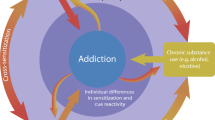Abstract
Cue reactivity, while increasingly recognized as a central feature of drug and alcohol addiction, is not well studied in gambling. We evaluated the urge to gamble in a simulated casino environment among frequent gamblers who alternated between cycles in which they observed others playing ten hands of Blackjack (first, third and fifth cycle) and cycles in which they played ten hands of Blackjack themselves (second and fourth cycle). The played cycles served as a manipulation for the observed cycles in terms of “priming” (having previously gambled in the environment vs. not) and “anticipation” (expecting more opportunities to gamble in the environment vs. not) and, thus, allowed these conditions: observed cycle 1 = anticipation (+) and prime (−); observed cycle 2 = anticipation (+) and prime (+); and observed cycle 3 = anticipation (−) and prime (+). Subjects’ urge to gamble was greater in the gambling environment than in a neutral setting and both positive anticipation and positive priming increased cue reactivity within the gambling environment. The frequency of gambling outside of the study did not affect cue reactivity. However, a preference for Blackjack (vs. other types of gambling) and observing winning (vs. losing) hands were both associated with stronger cue reactivity in the study. These findings contribute to our understanding of pathological gambling.


Similar content being viewed by others

References
Blanco, C., Moreyra, P., Nunes, E. V., Saiz-Ruiz, J., & Ibanez, A. (2001). Pathological gambling: Addiction or compulsion? Seminars in Clinical Neuropsychiatry, 6, 167–176.
Carter, B. L., & Tiffany, S. T. (1999). Meta-analysis of cue-reactivity in addiction research. Addiction, 94, 327–340.
Castellani, B., & Rugle, L. (1995). A comparison of pathological gamblers to alcoholics and cocaine misusers on impulsivity, sensation seeking, and craving. International Journal of Addiction, 30, 275–289.
Drummond, D. C., Tiffany, S. T., Glautier, S., & Remington, B. (1995). Cue exposure in understanding and treating addictive behavior. In D. C. Drummond, S. T. Tiffany, S. Glautier, & B. Remington (Eds.), Addictive behaviors: Cue exposure theory and practice (pp. 17). London: John Wiley & Sons.
Echeburua, E., Baez, C., & Fernandex-Montalvo, J. (1996). Comparaive effectiveness of three therapeutic modalities in psychological treatment of pathological gambling. Behavioral and Cognitive Psychotherapy, 24, 51–72.
Echeburua, E., Fernandez-Montalvo, J., & Baez, C. (2000). Prevention in the treatment of slot-machine pathological gambling: Long-term outcomes. Behavior Therapy, 31, 351–364.
Ehrman, R. N., Robbins, S. J., Childress, A. R., Goehl, L., Hole, A. V., & O’Brien, C. P. (1998). Laboratory exposure to cocaine cues does not increase cocaine use by outpatient subjects. Journal of Pharmacology and Experimental Therapeutics, 15, 431–435.
Grant, J. E., Kushner, M. G., & Kim, S. W. (2002). Pathological gambling and alcohol use disorder. Alcohol Research and Health, 26(2), 143–150.
Kushner, M. G., Abrams, K., Thuras, P., Frost, R., Kim, S. W., & Donahue, C. B. (2007). Urge to gamble in pathological gamblers exposed to a casino environment. Journal of Gambling Studies, 23, 121–132.
Lesieur, H. R. (1979). The compulsive gambler’s spiral of options and involvement. Psychiatry: Journal for the Study of Interpersonal Processes, 42(1), 79–87.
Lesieur, H. R., & Blume, S. B. (1987). The south oaks gambling screen (SOGS): A new instrument for the identification of pathological gamblers. American Journal of Psychiatry, 144(9), 1184–1188.
Laberg, J. C. (1990). What is presented, and what prevented, in cue exposure and response prevention with alcohol dependent subjects? Addictive Behaviors, 15(4), 367–386.
Litt, M. D., & Cooney, N. L. (1999). Inducing craving for alcohol in the laboratory. Alcohol Research and Health, 23(3), 174–178.
Marlatt, G. A., & Gordon, J. R. (1985). Relapse prevention maintenance strategies in the treatment of addictive behaviors. New York: Guildford Press.
McConaghy, N., Blaszczynski, A., & Frankova, A. (1991). Comparison of imaginal desensitization with other behavioural treatments of pathological gambling: A two- to nine-year follow-up. British Journal of Psychiatry, 159, 390–393.
Monti, P. M., Rosenhow, D. J., Rubonis, A. V., Niaura, R. S., Sirota, A. D., Colby, S. M., Goddard, P., & Abrams, D. B. (1993). Cue exposure coping skills treatment for male alcoholics: A preliminary investigation. Journal of Consulting and Clinical Psychology, 61, 1011–1019.
Potenza, M. N., Kosten, T. R., & Rounsaville, B. J. (2001). Pathological gambling. Journal of the American Medical Association, 286, 141–144.
Sharpe, L., & Tarrier, N. (1993). Towards a cognitive-behavioural theory of problem gambling. British Journal of Psychiatry, 162, 407–412.
Symes, R. A., & Nicki, R. M. (1997). A preliminary consideration of cue-exposure, response prevention treatment for pathological gambling behaviour: Two case studies. Journal of Gambling Studies, 13, 145–157.
Tavares, H., Zilberman, M. L., & el-Guebaly, N. (2003). Are there cognitive and behavioral approaches specific to the treatment of pathological gambling? Canadian Journal of Psychiatry, 48(1), 22–27.
Toneatto, T., & Ladouceur, R. (2003). Treatment of pathological gambling: A critical review of the literature. Psychology of Addictive Behaviors, 17(4), 284–292.
Winters, K., & Stinchfield, R. (1999). Treatment of pathological gamblers. In Pathological gambling: A critical review (pp. 192–236). National Research Counsel, Washington DC: National Academy Press.
Wray, I., & Dickerson, M. G. (1986). Cessation of high frequency gambling and sexual compulsions. Journal of Clinical Psychiatry, 47, 201–203.
Wray, I., Phil, M., & Dickerson, M. G. (1981). Cessation of high frequency gambling and “withdrawal” symptoms. British Journal of Addiction, 76, 401–405.
Author information
Authors and Affiliations
Corresponding author
Rights and permissions
About this article
Cite this article
Kushner, M., Thurus, P., Sletten, S. et al. Urge to Gamble in a Simulated Gambling Environment. J Gambl Stud 24, 219–227 (2008). https://doi.org/10.1007/s10899-007-9083-3
Received:
Accepted:
Published:
Issue Date:
DOI: https://doi.org/10.1007/s10899-007-9083-3


